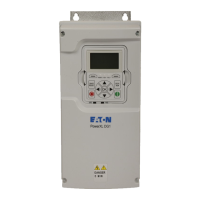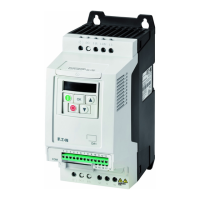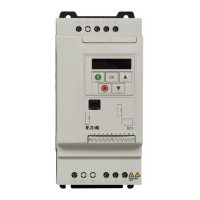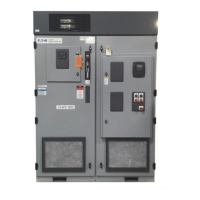Chapter 4—Safety and Switching
16 DG1 Series VFD MN040002EN—March 2014 www.eaton.com
Chapter 4—Safety and Switching
Fuses and Cable Cross-Sections
The fuses and wire cross-sections allocated for power-side
connections depend on the rated input current and output
current of the frequency inverter (without AC choke).
CAUTION
When selecting the cable cross-section, take the voltage
drop under load conditions into account.
The consideration of other standards (for example, VDE 0113
or VDE 0289) is the responsibility of the user.
The national and regional standards (for example VDE 0113,
EN 60204) must be observed and the necessary approvals
(for example UL) at the site of installation must be fulfilled.
When the device is operated in a UL-approved system, use
only UL-approved fuses, fuse bases, and cables.
See
Appendix D
—Safety Instructions for UL and cUL for
details.
CAUTION
The specified minimum PE conductor cross-sections in this
manual must be maintained. The minimum size of the
protective earthing conductor must comply with the
requirements of EN 61800-5-1 and/or the local safety
regulations.
Touch currents in this frequency inverter are greater than
3.5 mA (AC). According to product standard IEC/EN 61800-5-1
,
an additional equipment grounding conductor of the same
cross-sectional area as the original protective earthing
conductor must be connected, or the cross-section of the
equipment grounding conductor must be at least 10 mm
2
Cu.
Choose the cross-section of the PE conductor in the motor
lines at least as large as the cross-section of the phase lines
(U, V, W).
Cables and Fuses
The cross-sections of the cables and line protection fuses
used must correspond with local standards.
For an installation in accordance with UL guidelines:
●
Use UL recognized Class T fuses for the branch circuit
protection
●
Use 75°C copper wire only
●
Use UL listed conduit fittings with the same type rating
(Type 1/Type 12) as the enclosure
See
Appendix D
—Safety Instructions for UL and cUL for
details.
Use power cables with insulation according to the specified
input voltages for the permanent installation. A shielded
cable is not required on the input side.
A completely (360°) shielded low impedance cable is
required on the motor side. The length of the motor cable
depends on the RFI class and must not exceed
approximately 300 ft (100m) without additional filtering.
Residual-Current Device (RCD)
RCD (Residual Current Device): Residual current device,
residual current circuit breaker (FI circuit breaker).
Residual current circuit breakers protect persons and animals
from the existence (not the origination) of impermissibly high
contact voltages. They prevent dangerous, and in some
cases deadly injuries caused by electrical accidents, and also
serve as fire prevention.
This drive can cause a DC current in the protective earthing
conductor. Where a residual current-operated protective
(RCD) or monitoring (RCM) device is used for protection in
case of direct or indirect contact, only an RCD or RCM of
Type B is allowed on the supply side of this product.
Figure 9. Identification on the FI Circuit Breakers
Frequency inverters work internally with rectified AC
currents. If an error occurs, the DC currents can block a type
A RCD circuit breaker from triggering and therefore disable
the protective functionality.
Debounced inputs may not be used in the safety circuit
diagram.
Residual current circuit breakers (RCD) are only to be
installed between the AC power supply network and the
frequency inverter.
AC/DC sensitive
(RCD, type B)

